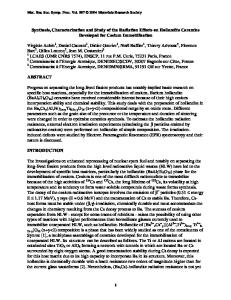Radiation Effects on Hollandite Ceramics developed for Radioactive Cesium Immobilization
- PDF / 208,494 Bytes
- 7 Pages / 612 x 792 pts (letter) Page_size
- 85 Downloads / 296 Views
R2.3.1
Radiation Effects on Hollandite Ceramics developed for Radioactive Cesium Immobilization V. Aubin1, D. Caurant1, D. Gourier1, N. Baffier1, S. Esnouf2 and T. Advocat3 1 LCAES (UMR CNRS 7574), ENSCP, 11 rue P.M. Curie, 75231 Paris, France 2 Commissariat à l’Energie Atomique, DSM/DRECAM/LSI, 91128 Palaiseau, France 3 Commissariat à l’Energie Atomique, DEN/DIEC/SCDV, 30207 Bagnols-sur-Cèze, France ABSTRACT Progress on separating the long-lived fission products from the high level radioactive liquid waste (HLW) has led to the development of specific host matrices, notably for the immobilization of cesium. Hollandite (nominally BaAl2Ti6O16), one of the main phases constituting Synroc, receives renewed interest as specific Cs-host wasteform. The radioactive cesium isotopes consist of short-lived 134Cs and 137Cs of high activities and 135Cs with long lifetime, all decaying according to Cs+→Ba2++e- (β) + γ. Therefore, Cs-host forms must be both heat and (β,γ)-radiation resistant. The purpose of this study is to estimate the stability of single phase hollandite under external β and γ radiation, simulating the decay of Cs. A hollandite ceramic of simple composition (Ba1.16Al2.32Ti5.68O16) was essentially irradiated by 1 and 2.5 MeV electrons with different fluences to simulate the β particles emitted by cesium. The generation of point defects was then followed by Electron Paramagnetic Resonance (EPR). All these electron irradiations generated defects of the same nature (oxygen centers and Ti3+ ions) but in different proportions varying with electron energy and fluence. The annealing of irradiated samples lead to the disappearance of the latter defects but gave rise to two other types of defects (aggregates of light elements and titanyl ions). It is necessary to heat at relatively high temperature (T=800°C) to recover an EPR spectrum similar to that of the pristine material. The stability of hollandite phase under radioactive cesium irradiation during the waste storage is discussed. INTRODUCTION Over the past few years, materials for the specific immobilization of radioactive cesium have been investigated because of the current progress on separating cesium from HLW with calixarenes complexes [1]. Several new materials have been proposed to specifically immobilize cesium: iron phosphate or aluminosilicate glasses [2,3], zeolite [4], pollucite [5] and hollandite [6]. Some of them do not offer enough improvement compared to the performance of the existing borosilicate glasses, currently used to immobilize unseparated HLW in France, UK, Russia, USA and Japan. Indeed, the chemical durability of these materials, except for hollandite, is in the best cases only one order of magnitude higher. Therefore, hollandite of [Ba2+xCs+y][(Al3+,Ti3+)2x+y Ti4+8-2x-y]O16 (x+y>δ(E0)). As its detection depends on the sample synthesis protocol used, it can be proposed that the corresponding Ti3+ ions would be of surface titanyl type. Electron irradiation β particles with energy in the Mega electron volt range can impart energy to the matri
Data Loading...











